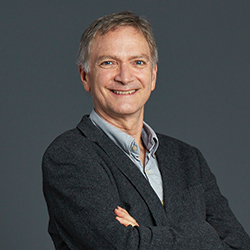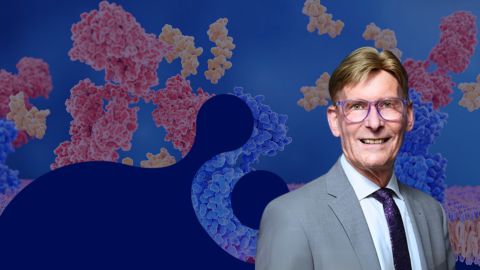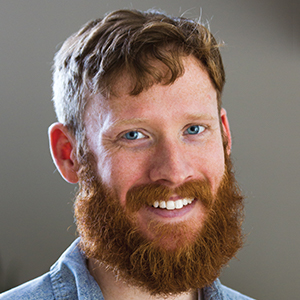Meet Thomas Neubert
Thomas A. Neubert, a professor of cell biology at New York University’s Skirball Institute of Biomolecular Medicine, joined the ranks of associate editors at the journal Molecular & Cellular Proteomics in June. Neubert, who is the director of the institute’s mass spectrometry core for neuroscience and is involved in a wide variety of collaborations utilizing mass spectrometry, spoke with John Arnst, ASBMB Today’s science writer. The interview has been edited for clarity and length.
 Thomas A. NeubertPHOTO COURTESY OF THOMAS NEUBERT
Thomas A. NeubertPHOTO COURTESY OF THOMAS NEUBERT
What is your group focused on?
We use mass spectrometry to study cell signaling, mostly in neurons. We do most of that in collaboration with neuroscientists through a grant from the National Institute of Neurological Disorders and Stroke that funds the NYU mass spectrometry core for neuroscience. Most of our projects are collaborative, and we spend quite a lot of time developing methods to do these projects. We have, I would say, about 30 different collaborative projects going on at any time.
For example, when we worked with Paul Mathews and Stephen Ginsberg at the Nathan Kline Institute and NYU, we found some very interesting and specific changes in phosphorylation of proteins in hippocampal neurons in monkeys with a form of Type I diabetes. The changes may help explain why people with diabetes are more susceptible to Alzheimer’s disease.
We helped NYU neuropathologists Matija Snuderl and David Zagzag by identifying the molecular composition of an interesting structure that helps tumors get blood supply without forming normal blood vessels.
I like to try to figure out how cells make decisions and work on a molecular level. For example, how do neurons know how to connect to the correct neurons when forming a brain, and how do these connections change when we learn? Mass spectrometry can be very good at getting a relatively comprehensive view of how cell signaling works if you do the right kind of experiment. A colleague at NYU, Moosa Mohammadi, has found that one type of growth factor ligand can correct a metabolic defect in cells, while another ligand can correct metabolism but also cause the cells to proliferate. We are now doing experiments to find out how these ligands exert their different effects. The ultimate goal would be to find a treatment for diabetes without causing cancer as a result of the diabetes treatment.
What is your background and research training?
My Ph.D. is from Johns Hopkins in immunology and infectious disease. After that, I did a postdoc with Jim Hurley at the University of Washington in Seattle, where I was studying vision signal transduction, and another short postdoc with Lubert Stryer at Stanford (University).
While I was studying the post-translational modification of transducin, which is the G-protein involved in vision signal transduction, I was lucky enough that another postdoc, Richard Johnson, was working two floors down in Ken Walsh’s lab in the biochemistry department at the University of Washington. Rich trained with Klaus Biemann, and Rich was a pioneer in using mass spec to study proteins. He helped me characterize post-translational modifications on transducin, and I realized then how powerful mass spectrometry was for protein chemistry. I learned as much as I could from Rich and have focused on using mass spectrometry to study proteins since then.
After working for a company in Germany for a few years, I took my current job in 1998 at New York University School of Medicine in the Skirball Institute, and I’ve been doing mass spec ever since.
What company did you work for?
It was Fournier Pharma in Heidelberg, a French family-owned company. While I was there, I met Matthias Mann, who was at the European Molecular Biology Laboratory at the time. I learned a lot from him about mass spectrometry and did a sabbatical in his lab at the Max Planck Institute in Martinsried near Munich in 2012.
Heidelberg is also where I met my wife. My kids and wife speak German at home in New York, so, when I’m speaking with the in-laws or visiting her family and friends, I have to dust off the German a little. When I was living in Germany, I was speaking German, but I was born in Ohio, so I’m not a native German speaker.
After three years, the family decided to sell the company, and they closed down the institute in Heidelberg where I was working. That’s when I moved to NYU.
What does it mean to you to be an associate editor of MCP?
It’s a great honor. MCP has a leadership position in the field of proteomics in the kind of articles they publish, and they institute guidelines. Whenever the field of proteomics struggles with a quality-control issue, MCP comes up with guidelines they require for publication. Those (guidelines) tend to be adopted by the rest of the proteomics community. MCP is a very important journal, and I’m very honored to be on as an associate editor.
MCP tries to get manuscripts reviewed very quickly, and the AEs are very important in the process. It requires setting aside time every day to work on (MCP). It can be a challenge when I get very busy at my day job running a lab at NYU. It requires developing good time-management skills, which I think I’m finally doing.
Do you have any words of wisdom or a favorite motto?
I think it’s important to keep in mind why we decided to become scientists in the first place. We want to make discoveries or cure diseases. The day-to-day struggles to get funding and publish papers can wear you down, and you lose sight of why it is you became a scientist.
Enjoy reading ASBMB Today?
Become a member to receive the print edition four times a year and the digital edition monthly.
Learn moreGet the latest from ASBMB Today
Enter your email address, and we’ll send you a weekly email with recent articles, interviews and more.
Latest in People
People highlights or most popular articles

Sketching, scribbling and scicomm
Graduate student Ari Paiz describes how her love of science and art blend to make her an effective science communicator.

Embrace your neurodivergence and flourish in college
This guide offers practical advice on setting yourself up for success — learn how to leverage campus resources, work with professors and embrace your strengths.

Survival tools for a neurodivergent brain in academia
Working in academia is hard, and being neurodivergent makes it harder. Here are a few tools that may help, from a Ph.D. student with ADHD.

Quieting the static: Building inclusive STEM classrooms
Christin Monroe, an assistant professor of chemistry at Landmark College, offers practical tips to help educators make their classrooms more accessible to neurodivergent scientists.

Hidden strengths of an autistic scientist
Navigating the world of scientific research as an autistic scientist comes with unique challenges —microaggressions, communication hurdles and the constant pressure to conform to social norms, postbaccalaureate student Taylor Stolberg writes.

Richard Silverman to speak at ASBMB 2025
Richard Silverman and Melissa Moore are the featured speakers at the ASBMB annual meeting to be held April 12-15 in Chicago.

